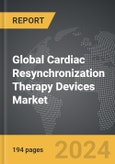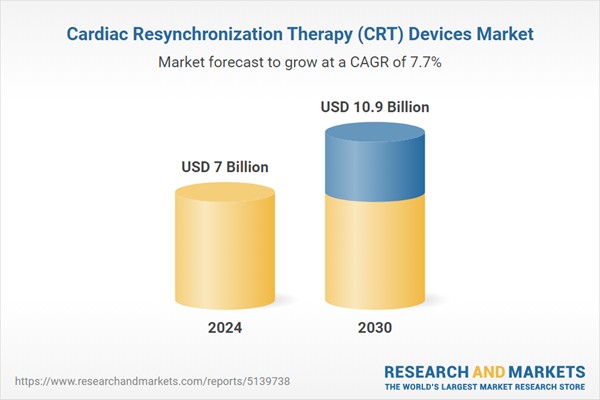The global market for Cardiac Resynchronization Therapy (CRT) Devices was valued at US$7.0 Billion in 2024 and is projected to reach US$10.9 Billion by 2030, growing at a CAGR of 7.7% from 2024 to 2030. This comprehensive report provides an in-depth analysis of market trends, drivers, and forecasts, helping you make informed business decisions. The report includes the most recent global tariff developments and how they impact the Cardiac Resynchronization Therapy (CRT) Devices market.
Segments: Segment (CRT-Defibrillator (CRT-D), CRT-Pacemaker (CRT-P)); End-Use (Hospitals & Cardiac Centers, Ambulatory Surgery Centers).
Geographic Regions/Countries: World; United States; Canada; Japan; China; Europe (France; Germany; Italy; United Kingdom; and Rest of Europe); Asia-Pacific; Rest of World.
The analysts continuously track trade developments worldwide, drawing insights from leading global economists and over 200 industry and policy institutions, including think tanks, trade organizations, and national economic advisory bodies. This intelligence is integrated into forecasting models to provide timely, data-driven analysis of emerging risks and opportunities.
Global Cardiac Resynchronization Therapy (CRT) Devices Market - Key Trends and Drivers Summarized
What Are Cardiac Resynchronization Therapy (CRT) Devices and Why Are They Essential?
Cardiac Resynchronization Therapy (CRT) devices are critical tools in the management of heart failure, particularly for patients suffering from electrical conduction problems that impair the heart’s ability to beat efficiently. These devices are designed to restore the coordinated contraction of the heart's ventricles, improving its overall pumping efficiency. CRT devices typically consist of a pacemaker or an implantable cardioverter-defibrillator (ICD) equipped with leads that are placed in both ventricles of the heart. By delivering synchronized electrical pulses to the ventricles, CRT devices correct the misalignment in heartbeats that is common in patients with heart failure or bundle branch block. This form of therapy is often prescribed for individuals who have moderate to severe heart failure and who have not responded well to conventional treatments. The ultimate goal of CRT is to reduce the symptoms of heart failure, such as shortness of breath and fatigue, improve the quality of life, and lower the risk of hospitalization or death. With heart failure affecting millions of people worldwide, CRT devices represent a vital intervention in the management of this chronic and often debilitating condition.How Is Technology Enhancing the Effectiveness of CRT Devices?
The technological evolution of CRT devices has significantly enhanced their effectiveness, safety, and the overall patient experience. One of the key advancements in this field has been the development of adaptive CRT systems that automatically adjust pacing based on a patient’s activity levels and heart rhythms. These systems utilize sophisticated algorithms to optimize therapy by ensuring the heart beats as efficiently as possible under various conditions, such as rest or exercise. Another major innovation is the integration of remote monitoring capabilities, allowing real-time transmission of patient data to healthcare providers. This enables clinicians to continuously monitor the performance of the device and the patient's heart condition without the need for frequent in-person visits. Remote monitoring not only improves patient outcomes through timely adjustments in therapy but also reduces the need for hospitalizations and emergency interventions. Additionally, the miniaturization of CRT devices has made them less invasive and more comfortable for patients. These smaller, more efficient devices now have longer battery lives and are easier to implant, reducing the risk of complications during surgery. The inclusion of wireless technology in CRT devices has further improved patient care, allowing for seamless communication between the device and external monitoring systems. As technology continues to advance, the precision and efficacy of CRT devices in treating heart failure are expected to grow, offering even better outcomes for patients.What Are the Key Market Trends in Cardiac Resynchronization Therapy Devices?
Several important trends are driving the cardiac resynchronization therapy devices market, shaped by advancements in technology, demographic shifts, and changes in healthcare delivery. One of the most notable trends is the increasing prevalence of heart failure globally, largely driven by aging populations and the rising incidence of conditions such as hypertension, diabetes, and coronary artery disease, all of which contribute to the onset of heart failure. This has fueled the demand for CRT devices as a treatment option for patients who are not responding to medications alone. Another key trend is the growing adoption of remote patient monitoring solutions. With healthcare systems increasingly moving towards digital platforms, CRT devices with remote monitoring capabilities are becoming more widespread. This not only improves patient management but also aligns with the global trend towards telemedicine and home-based care. Furthermore, the ongoing miniaturization of CRT devices and the development of leadless versions are set to revolutionize the market by making the devices less invasive and reducing the potential for lead-related complications. Regulatory approval of these innovative devices is accelerating, particularly in developed regions like North America and Europe, where regulatory agencies have streamlined processes to get these life-saving technologies to patients faster. Lastly, the expansion of healthcare coverage and reimbursement policies in several regions is making CRT devices more accessible to a broader patient population, driving increased adoption.What Are the Factors Driving Expansion of the CRT Devices Market?
The growth in the cardiac resynchronization therapy devices market is driven by several key factors tied to advancements in technology, shifts in healthcare trends, and changing patient demographics. A primary driver is the rising prevalence of heart failure across the globe, particularly in aging populations. As the number of heart failure patients continues to increase, so does the demand for effective treatment options like CRT, which is especially critical for patients who do not respond to conventional heart failure therapies. The ongoing advancements in CRT technology, such as the development of adaptive CRT devices and the integration of remote monitoring capabilities, have significantly enhanced the appeal of these devices. Adaptive systems that automatically adjust pacing parameters based on patient-specific needs improve therapy effectiveness and reduce the likelihood of complications. Moreover, the widespread adoption of telemedicine and remote patient monitoring has boosted the demand for CRT devices that can seamlessly transmit data, allowing for more proactive and efficient management of heart failure patients. The shift toward home-based care, further accelerated by the COVID-19 pandemic, has emphasized the importance of remote monitoring in chronic disease management. Another driver is the increasing focus on reducing hospital readmissions and improving long-term outcomes, which has led healthcare systems to embrace value-based care models. CRT devices, by improving heart function and reducing the need for emergency interventions, align well with these healthcare goals. Additionally, advancements in device miniaturization and battery life are making CRT devices more accessible, less invasive, and more durable, leading to higher patient satisfaction and better overall adoption. Finally, favorable regulatory policies and expanding healthcare coverage, especially in developed markets, have made it easier for patients to access these life-saving devices, further fueling market growth.Report Scope
The report analyzes the Cardiac Resynchronization Therapy (CRT) Devices market, presented in terms of units. The analysis covers the key segments and geographic regions outlined below.Segments: Segment (CRT-Defibrillator (CRT-D), CRT-Pacemaker (CRT-P)); End-Use (Hospitals & Cardiac Centers, Ambulatory Surgery Centers).
Geographic Regions/Countries: World; United States; Canada; Japan; China; Europe (France; Germany; Italy; United Kingdom; and Rest of Europe); Asia-Pacific; Rest of World.
Key Insights:
- Market Growth: Understand the significant growth trajectory of the CRT-Defibrillator (CRT-D) segment, which is expected to reach US$7.8 Billion by 2030 with a CAGR of a 7.4%. The CRT-Pacemaker (CRT-P) segment is also set to grow at 8.4% CAGR over the analysis period.
- Regional Analysis: Gain insights into the U.S. market, valued at $2.0 Billion in 2024, and China, forecasted to grow at an impressive 7.3% CAGR to reach $1.7 Billion by 2030. Discover growth trends in other key regions, including Japan, Canada, Germany, and the Asia-Pacific.
Why You Should Buy This Report:
- Detailed Market Analysis: Access a thorough analysis of the Global Cardiac Resynchronization Therapy (CRT) Devices Market, covering all major geographic regions and market segments.
- Competitive Insights: Get an overview of the competitive landscape, including the market presence of major players across different geographies.
- Future Trends and Drivers: Understand the key trends and drivers shaping the future of the Global Cardiac Resynchronization Therapy (CRT) Devices Market.
- Actionable Insights: Benefit from actionable insights that can help you identify new revenue opportunities and make strategic business decisions.
Key Questions Answered:
- How is the Global Cardiac Resynchronization Therapy (CRT) Devices Market expected to evolve by 2030?
- What are the main drivers and restraints affecting the market?
- Which market segments will grow the most over the forecast period?
- How will market shares for different regions and segments change by 2030?
- Who are the leading players in the market, and what are their prospects?
Report Features:
- Comprehensive Market Data: Independent analysis of annual sales and market forecasts in US$ Million from 2024 to 2030.
- In-Depth Regional Analysis: Detailed insights into key markets, including the U.S., China, Japan, Canada, Europe, Asia-Pacific, Latin America, Middle East, and Africa.
- Company Profiles: Coverage of players such as Abbott Cardiovascular, Biotronik SE & Co. KG, Boston Scientific Corporation, EBR Systems, Inc., Lepu Medical Technology (Beijing) Co., Ltd. and more.
- Complimentary Updates: Receive free report updates for one year to keep you informed of the latest market developments.
Some of the 42 companies featured in this Cardiac Resynchronization Therapy (CRT) Devices market report include:
- Abbott Cardiovascular
- Biotronik SE & Co. KG
- Boston Scientific Corporation
- EBR Systems, Inc.
- Lepu Medical Technology (Beijing) Co., Ltd.
- LivaNova PLC
- Medico SpA
- Medtronic Plc
- MicroPort Scientific Corporation
- Osypka Medical GmbH
Tariff Impact Analysis: Key Insights for 2025
Global tariff negotiations across 180+ countries are reshaping supply chains, costs, and competitiveness. This report reflects the latest developments as of April 2025 and incorporates forward-looking insights into the market outlook.The analysts continuously track trade developments worldwide, drawing insights from leading global economists and over 200 industry and policy institutions, including think tanks, trade organizations, and national economic advisory bodies. This intelligence is integrated into forecasting models to provide timely, data-driven analysis of emerging risks and opportunities.
What’s Included in This Edition:
- Tariff-adjusted market forecasts by region and segment
- Analysis of cost and supply chain implications by sourcing and trade exposure
- Strategic insights into geographic shifts
Buyers receive a free July 2025 update with:
- Finalized tariff impacts and new trade agreement effects
- Updated projections reflecting global sourcing and cost shifts
- Expanded country-specific coverage across the industry
Table of Contents
I. METHODOLOGYII. EXECUTIVE SUMMARY2. FOCUS ON SELECT PLAYERSIII. MARKET ANALYSISIV. COMPETITION
1. MARKET OVERVIEW
3. MARKET TRENDS & DRIVERS
4. GLOBAL MARKET PERSPECTIVE
UNITED STATES
CANADA
JAPAN
CHINA
EUROPE
FRANCE
GERMANY
ITALY
UNITED KINGDOM
REST OF EUROPE
ASIA-PACIFIC
REST OF WORLD
Companies Mentioned (Partial List)
A selection of companies mentioned in this report includes, but is not limited to:
- Abbott Cardiovascular
- Biotronik SE & Co. KG
- Boston Scientific Corporation
- EBR Systems, Inc.
- Lepu Medical Technology (Beijing) Co., Ltd.
- LivaNova PLC
- Medico SpA
- Medtronic Plc
- MicroPort Scientific Corporation
- Osypka Medical GmbH
Table Information
| Report Attribute | Details |
|---|---|
| No. of Pages | 194 |
| Published | April 2025 |
| Forecast Period | 2024 - 2030 |
| Estimated Market Value ( USD | $ 7 Billion |
| Forecasted Market Value ( USD | $ 10.9 Billion |
| Compound Annual Growth Rate | 7.7% |
| Regions Covered | Global |









